Cedar Mesa Sandstone facts for kids
Quick facts for kids Cedar Mesa SandstoneStratigraphic range: Early Permian, 286–245Ma |
|
|---|---|

|
|
| Type | Geological member |
| Unit of | Cutler Formation |
| Underlies | Organ Rock Shale |
| Overlies | Elephant Canyon Formation Halgaito Member |
| Lithology | |
| Primary | Sandstone |
| Location | |
| Coordinates | 37°23′N 109°55′W / 37.383°N 109.917°W |
| Region | Colorado Plateau |
| Country | United States |
| Type section | |
| Named for | Cedar Mesa |
| Named by | Arthur A. Baker John B. Reeside, Jr., 1929 |
The Cedar Mesa Sandstone is a special type of sandstone rock layer. It's part of a bigger rock group called the Cutler Formation. You can find this rock in the southwestern United States, including parts of Utah, Colorado, New Mexico, and Arizona.
What is Cedar Mesa Sandstone?
This rock layer is made from ancient sand dunes that were once along a coast. These dunes turned into rock about 245 to 286 million years ago, during a time called the Permian period.
How it Formed
The Cedar Mesa Sandstone often has cool red and white stripes. This happened because floods sometimes carried red, iron-rich dirt from nearby mountains when the rock was forming. This iron mixed with the sand, giving it its unique colors.
Where to Find It
The Cedar Mesa Sandstone gets its name from a place called Cedar Mesa in Utah, near the San Juan River.
You can see this rock forming tall spires and deep canyons in places like Canyonlands National Park. It also makes the amazing natural bridges at Natural Bridges National Monument.
Images for kids
-
Druid Arch in Canyonlands National Park, an eroded fin of Cedar Mesa Sandstone


